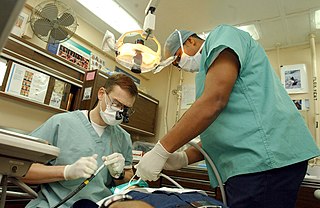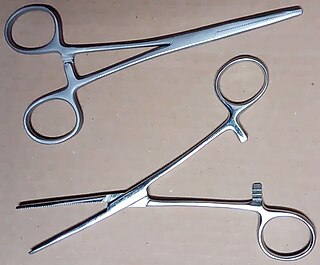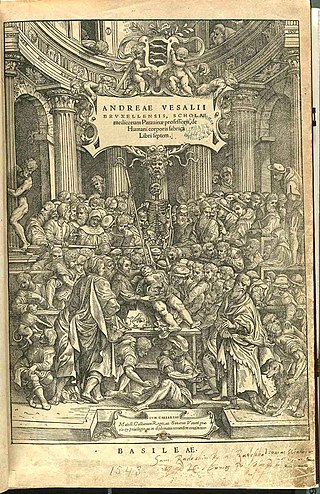Related Research Articles

A dentist, also known as a dental surgeon, is a health care professional who specializes in dentistry, the branch of medicine focused on the teeth, gums, and mouth. The dentist's supporting team aids in providing oral health services. The dental team includes dental assistants, dental hygienists, dental technicians, and sometimes dental therapists.

A hemostat is a tool used to control bleeding during surgery. Similar in design to both pliers and scissors, it is used to clamp exposed blood vessels shut.

Abū al-Qāsim Khalaf ibn al-'Abbās al-Zahrāwī al-Ansari, popularly known as al-Zahrawi (الزهراوي), Latinised as Albucasis or Abulcasis, was a physician, surgeon and chemist from al-Andalus. He is considered one of the greatest surgeons of the Middle Ages.

In surgery or medical procedure, a ligature consists of a piece of thread (suture) tied around an anatomical structure, usually a blood vessel, another hollow structure or an accessory skin tag to shut it off.

Ambroise Paré was a French barber surgeon who served in that role for kings Henry II, Francis II, Charles IX and Henry III. He is considered one of the fathers of surgery and modern forensic pathology and a pioneer in surgical techniques and battlefield medicine, especially in the treatment of wounds. He was also an anatomist, invented several surgical instruments, and was a member of the Parisian barber surgeon guild.

Gemma Frisius was a Dutch physician, mathematician, cartographer, philosopher, and instrument maker. He created important globes, improved the mathematical instruments of his day and applied mathematics in new ways to surveying and navigation. Gemma's rings, an astronomical instrument, are named after him. Along with Gerardus Mercator and Abraham Ortelius, Frisius is often considered one of the founders of the Netherlandish school of cartography, and significantly helped lay the foundations for the school's golden age.
The year 1590 in science and technology involved some significant events.
Aromaticum rosatum was a powder used in traditional medicine made of red roses, liquorice, aloeswood, yellowheart, cinnamon, cloves, mace, gum tragacanth, nutmegs, cardamoms, galangals, spikenard, ambergris, and musk mixed together. It was chiefly prescribed in cordial and cephalic boles and electuaries. It was believed to act as a tonic on the heart, stomach and liver.

The Medical Renaissance, from around 1400 to 1700 CE, was a period of progress in European medical knowledge, with renewed interest in the ideas of the ancient Greek, Roman civilizations and Islamic medicine, following the translation into Medieval Latin of many works from these societies. Medical discoveries during the Medical Renaissance are credited with paving the way for modern medicine.

CorneliusGemma was a Flemish physician, astronomer and astrologer, and the oldest son of cartographer and instrument-maker Gemma Frisius. He was a professor of medicine at the Catholic University of Leuven, and shared in his father's efforts to restore ancient Ptolemaic practice to astrology, drawing on the Tetrabiblos.

Ambroise Tardieu was a French cartographer and engraver, and is celebrated for his version of John Arrowsmith's 1806 map of the United States.

The year 1535 in science and technology included a number of events, some of which are listed here.
The year 1545 in science and technology involved some significant events.
Various individuals have advanced the surgical art and, as a result, have been called the Father of Surgery by various sources.
The year 1569 in science and technology included a number of events, some of which are listed here.
The year 1510 in science and technology included many events, some of which are listed here.

A unicorn horn, also known as an alicorn, is a legendary object whose reality was accepted in Europe and Asia from the earliest recorded times. This "horn" comes from the creature known as a unicorn, also known in the Hebrew Bible as a re'em or wild ox. Many healing powers and antidotal virtues were attributed to the alicorn, making it one of the most expensive and reputable remedies during the Renaissance, and justifying its use in the highest circles. Beliefs related to the alicorn influenced alchemy through spagyric medicine. The horn's purificational properties were eventually put to the test in, for example, the book of Ambroise Paré, Discourse on unicorn.
Jean Canappe was a French physician who was attached to Francis I of France in 1542. He sometimes wrote under the pseudonym Philiatros and was known because he contributed to the transmission of medical and surgical knowledge in French with Pierre Tolet.
Séverin Pineau, in Latin Severinus Pinaeus Carnutensis, was a Parisian physician and surgeon to the king.
References
- ↑ University of Oklahoma Libraries, History of Science Collections, Recent Acquisitions, "The First Book Printed on Tycho Brahe's Printing Press at Uraniborg: Diarium, 1586," The Lynx2 (November 2005), p. 9 online Archived 2010-07-20 at the Wayback Machine with Gemma's illustration.
- ↑ "Cornelius Gemma: Cosmology, Medicine and Natural Philosophy in Renaissance Louvain conference proceedings". Archived from the original on 2011-10-06. Retrieved 2011-06-02.